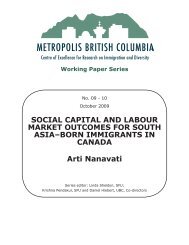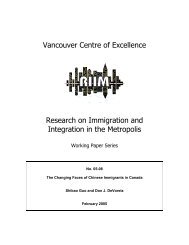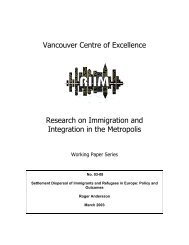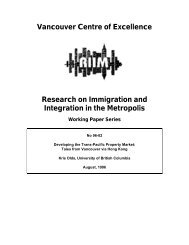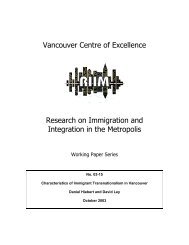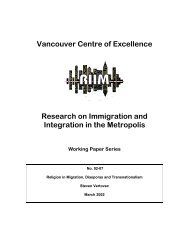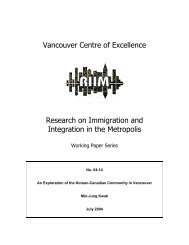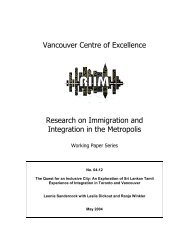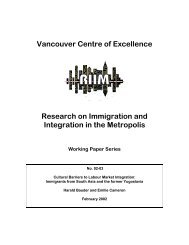Modernization and Global Restructuring of Women's Work
Modernization and Global Restructuring of Women's Work
Modernization and Global Restructuring of Women's Work
Create successful ePaper yourself
Turn your PDF publications into a flip-book with our unique Google optimized e-Paper software.
21<br />
not even assumed a faint shape: immigrant women’s lives do not form part <strong>of</strong> the social <strong>and</strong> national<br />
imagination <strong>of</strong> the state.<br />
Within the analytical framework <strong>of</strong> this paper, the political economic perspective <strong>of</strong> the<br />
race/gender/class paradigm cannot be considered as the full story. This observation needs to be made<br />
as accounts <strong>of</strong> immigrant women’s work ends on this note. The second paradigm <strong>of</strong> civil/small<br />
voices informs us that for Nadia coming to Canada did not only lead to the erasure <strong>of</strong> her pr<strong>of</strong>essional<br />
life but also the nuances <strong>and</strong> contexts <strong>of</strong> the larger project <strong>of</strong> modernity <strong>and</strong> gender where Nadia was<br />
an active player.<br />
Conclusion<br />
Let me conclude by recapitulating the main points <strong>of</strong> this paper. First, I have attempted to respond to<br />
Nadia’s question: “Why is it hard for a pr<strong>of</strong>essional non-western woman to find work in Canada?”<br />
The race/class/gender paradigm has provided part <strong>of</strong> the answer. As interactive/ intersectional mode<br />
<strong>of</strong> oppression, these socially constructed categories have brought into relief ways <strong>and</strong> means through<br />
which non-white pr<strong>of</strong>essional women are generally channelled into low paying jobs. Here we may<br />
note that legislative attempts to remedy labour market inequalities in Canada - the Employment<br />
Equity Act/Bill C62 – did not substantively include women <strong>of</strong> colour compared with “visible<br />
minority” men <strong>and</strong> white women (Boyd: 1992). Nadia’s story brings to light how the process <strong>of</strong><br />
exclusion <strong>of</strong> women <strong>of</strong> colour from pr<strong>of</strong>essional work is affected. Through her narrative, Nadia<br />
shows how her search for work in her area <strong>of</strong> expertise in fact channelled her into ghettoized deadend<br />
jobs. Immigrant women’s work in this sector is desirable as it serves multiple ends: it fills in the<br />
gaps created by the downsizing <strong>of</strong> the social service sector; it keeps immigrant women in their place<br />
as they are not expected to “fill the pr<strong>of</strong>essional social space, but that <strong>of</strong> manual <strong>and</strong> industrial labour<br />
or the lower levels <strong>of</strong> white collar jobs” (Bannerji 1995:134); <strong>and</strong> it provides cheap labour to fuel the<br />
capitalist <strong>and</strong> increasingly global market economy.<br />
In the process <strong>of</strong> relating her experiences <strong>of</strong> structural exclusion, Nadia brings to the fore a<br />
second story <strong>of</strong> gender <strong>and</strong> modernity as it unfolds in her country <strong>of</strong> origin. This second story is<br />
explicated by Abu-Lughod (1998) with reference to three points. First is the way in which women<br />
are incorporated into the political agenda <strong>of</strong> the state <strong>and</strong> global capitalism, discursively as well as<br />
materially. The discursive aspect comes into play in the way in which women <strong>and</strong> their bodies<br />
(veiling/unveiling <strong>and</strong> other forms <strong>of</strong> surveillance) “have become potent symbols <strong>of</strong> identity <strong>and</strong><br />
visions <strong>of</strong> society <strong>and</strong> the nation” (ibid: 1998:3). Materially, non-western women’s low-paid work



